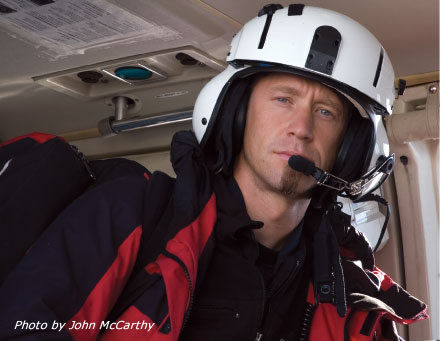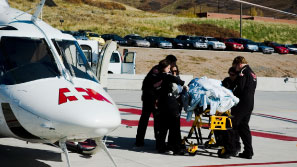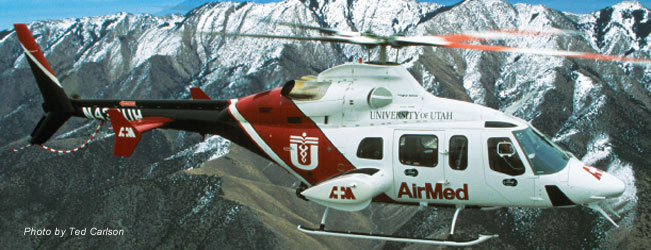
|
|
About Continuum Advertising Advisory Committee Archives Contact Us Continuum Home Faculty/Staff Subscribe related websites Alumni Association Marketing & Communications University of Utah Home |

|
 |
| Kris Pietryga, a flight nurse for AirMed, moved to Utah seven years ago for the mountains. Now, the mountains are a regular part of his workday. |
Take, for example, the time when AirMed’s flagship Bell 430, large enough to carry two patients, headed westward along I-215. An abrupt end to the trail of brake lights marked the accident scene. Flight nurse Kris Pietryga was the first man out, his ponytail flailing under the rotor wash. This clown is stuck in the car, he radioed back. “They thought I was being a jerk,” he recalls with a matter-of-fact grin. “But this was a woman in a full clown suit. The make-up, the red wig, even the big shoes. It scared the hell out of me.”
On a quiet day, the inertia kills him. By mid-afternoon, Pietryga has caught up on his duties and paperwork, watched extreme sports reruns on the flight base TV, made reservations for a surfing trip to Nicaragua, and even donned scrub pants and a T-shirt to wash the helicopters with a bucket full of sponges. “Let’s go someplace, Wayne,” he says. “I’m freaking out.” When their pagers chirp with a routine request to help with a tough IV start down the hall, Pietryga jumps to take it, but Edginton challenges him and, as everyone knows, rock crushes scissors, so Pietryga slumps back into his seat. “I’m going stir crazy.”
Pietryga moved to Utah for the mountains, leaving Detroit seven years ago for stints in a local ER and ICU before joining AirMed. Now those mountains are a regular part of his workday.
AirMed handles 70 percent of all airborne evacuations from local ski resorts, and makes countless year-round trips to the backcountry.
AirMed covers one of the largest geographic areas in the country, from its headquarters at University Hospital and five satellite bases in Ogden, Provo, and Park City, Utah; Ely, Nev; and Rock Springs, Wyo.
It’s not uncommon for the crew—a nurse and paramedic, usually, plus, in some cases, a respiratory therapist—to ride off from the landing zone on a snowmobile. “Best damn nursing job ever,” says Pietryga.
Ground crews usually arrive first, assess the scene, and prepare the patient for air transport. AirMed is there to keep the patient stable and get him or her to the doctor faster than otherwise possible. Ideally, individuals should be on an operating table within the first hour of major trauma—called the Golden Hour—because it drastically improves the patient’s chances of survival. But crews never know what they’ll find on the scene.
In fall 2005, Wisecup flew deep into rural Utah, using night-vision goggles to find a wide spot in the trail to set the bird down. Pietryga trekked a steep quarter-mile down the mountain to a 76-year-old hunter lying immobile but alert under his four-wheeler near the side of a cliff. When a search and rescue unit caught up, they flipped the ATV with a winch, pushing the hunter’s rifle, still in the gun rack, up against Pietryga’s chest. He asked the injured hunter, “Is this thing loaded?”
“And the dude says ‘Of course it is,’ ” Pietryga recalls, smirking and shaking his head. “We do some good stuff. It never is exactly the same.”
AirMed crews may live like action heroes, but this is no Hollywood production. Nobody is BASE-jumping out of an airborne helicopter or massaging a patient’s exposed heart for hour-long flights to the ER. “It wouldn’t be great TV to show us working an arrest, then getting back in the helicopter and flying home without him,” Edginton says, “but CPR all the way is pretty much fantasy.” And as much as they live for the rush of adrenaline, they do so within logical limits. “You have to make this decision of risk versus benefit.”
In that margin of choice lies their vulnerability.
On Jan. 11, 1998, paramedic Tim Hynes, nurse Shayne Carnahan, and pilot Stan Berg lifted off on a bright winter day, on their way to pick up an avalanche victim in Little Cottonwood Canyon. It was a routine call, but every second counted for the man on the stretcher. The nurse and paramedic shuffled him across the snow, bending against the rotor wash to place his inert form inside. But as the double doors slammed shut and the helicopter rose, the crew didn’t know they were flying straight into a sudden winter storm, a deadly wall of wind and snow. It hit them at the mouth of the canyon, smashing the bird against the mountainside like a giant gnat.
 The
AirMed crew gave their lives trying to save another. Pointing out the
shrine on the wall at AirMed headquarters—a few portraits, a plaque,
and some framed, heartfelt EMT poetry—Edginton tells it almost
like something he saw on TV, but the hesitation in his voice proves
otherwise. Hynes was the one who prompted Edginton to join AirMed, where
they worked together for 12 years. But both knew what they were risking,
and Edginton’s paternal eyes reflect a mixture of sadness and
respect for a friend who has become one more war story on a slow day
at flight base.
The
AirMed crew gave their lives trying to save another. Pointing out the
shrine on the wall at AirMed headquarters—a few portraits, a plaque,
and some framed, heartfelt EMT poetry—Edginton tells it almost
like something he saw on TV, but the hesitation in his voice proves
otherwise. Hynes was the one who prompted Edginton to join AirMed, where
they worked together for 12 years. But both knew what they were risking,
and Edginton’s paternal eyes reflect a mixture of sadness and
respect for a friend who has become one more war story on a slow day
at flight base.
Pietryga describes it best. “This is probably the closest teamwork you can get,” he says. “You work so close in such odd and strange circumstances. So when you lose someone like that, it’s tough on the team.”
Despite the danger and the heartbreak of losing comrades, the AirMed crew continues to take to the skies thousands of times every year. “One second somebody’s driving down the freeway going home. The next, he’s in a helicopter,” Pietryga says. “This job shows you how fragile life is.”
—Chad Nielsen is a Salt Lake City-based freelance writer. This is his first article for Continuum
